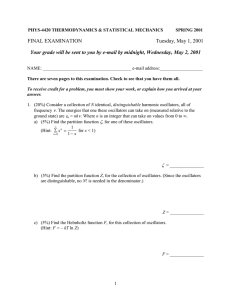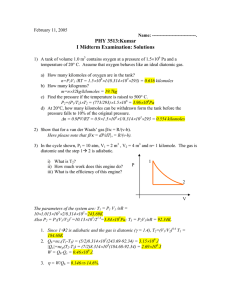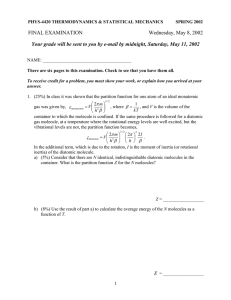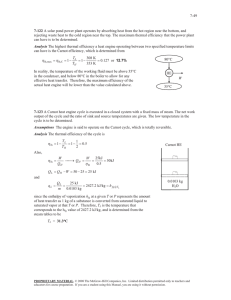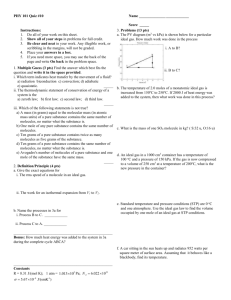s04final.doc
advertisement
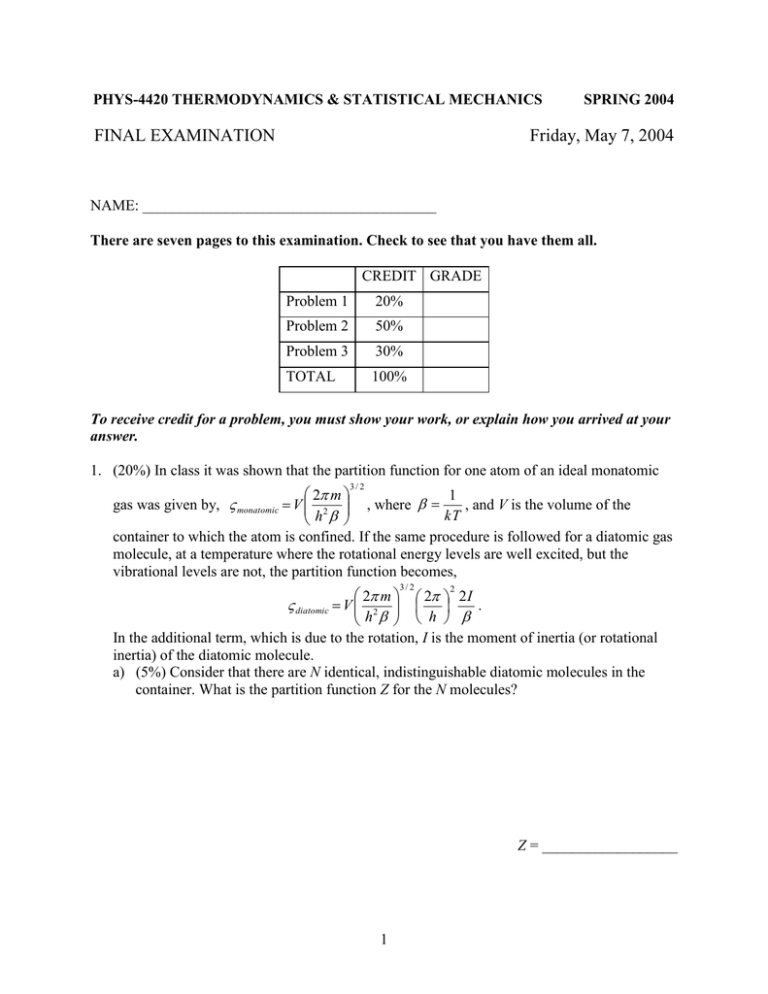
PHYS-4420 THERMODYNAMICS & STATISTICAL MECHANICS FINAL EXAMINATION SPRING 2004 Friday, May 7, 2004 NAME: _______________________________________ There are seven pages to this examination. Check to see that you have them all. CREDIT GRADE Problem 1 20% Problem 2 50% Problem 3 30% TOTAL 100% To receive credit for a problem, you must show your work, or explain how you arrived at your answer. 1. (20%) In class it was shown that the partition function for one atom of an ideal monatomic 3/ 2 2 m 1 gas was given by, monatomic V 2 , where , and V is the volume of the kT h container to which the atom is confined. If the same procedure is followed for a diatomic gas molecule, at a temperature where the rotational energy levels are well excited, but the vibrational levels are not, the partition function becomes, 3/ 2 2 m 2 2 I . diatomic V 2 h h In the additional term, which is due to the rotation, I is the moment of inertia (or rotational inertia) of the diatomic molecule. a) (5%) Consider that there are N identical, indistinguishable diatomic molecules in the container. What is the partition function Z for the N molecules? 2 Z = __________________ 1 b) (5%) Use the result of part a) to calculate the average energy of the N molecules as a function of T. E = __________________ c) (5%) Use the result of part a) to calculate the Helmholtz function F for the N molecules. F = __________________ d) (5%) Use the Helmholtz function to calculate the pressure of the gas as a function of temperature and volume. This should give the same ideal gas formula as a monatomic gas. p = __________________ 2 2. (50%) The figure shows a p-V diagram, for n moles of a monatomic ideal gas, dreamed up by an entrepreneur who wants to improve on the Carnot cycle. The cycle begins at a where the pressure is p0, the volume is V0, and the temperature in T0. It proceeds along the isobaric path ab to b, where the volume is 2V0. Then it goes along the isothermal bc to c where the volume is 4V0. Next it goes along the isobaric cd to d where the volume is 2V0, and finally along the isothermal da back to a. (Remember: pV = nRT) a) (4%) Calculate the pressure and temperature at point b, in terms of p0, V0, and T0. pb = __________________ Tb = __________________ b) (4%) Calculate the pressure and temperature at point c, in terms of p0, V0, and T0. pc = __________________ Tc = __________________ 3 c) (4%) Calculate the pressure and temperature at point d, in terms of p0, V0, and T0. pd = __________________ Td = __________________ d) (6%) Calculate the work done by the gas and the heat added to the gas as the system goes from a to b. Express your answers in terms of p0 and V0. Wab = __________________ Qab = __________________ e) (6%) Calculate the work done by the gas and the heat added to the gas as the system goes from b to c. Express your answers in terms of p0 and V0. Wbc = __________________ Qbc = __________________ f) (6%) Calculate the work done by the gas and the heat added to the gas as the system goes from c to d. Express your answers in terms of p0 and V0. (Hint: These are both negative.) Wcd = __________________ Qcd = __________________ 4 g) (6%) Calculate the work done by the gas and the heat added to the gas as the system goes from d to a. Express your answers in terms of p0 and V0. (Hint: These are both negative.) Wda = __________________ Qda = __________________ h) (3%) Calculate the net work done by the system as it goes around the complete cycle. Express your answer in terms of p0 and V0. W = __________________ i) (3%) Calculate the net heat that goes into the system as it goes around the complete cycle. Express your answer in terms of p0 and V0. Q = __________________ j) (3%) Calculate the efficiency of this engine. (Hint: This should be a pure number. If you can not get rid of constants, be sure you explain what you are trying to calculate.) = __________________ k) (3%) What would be the efficiency of a Carnot engine that could be operated between the highest and the lowest temperatures that this system reaches. (Hint: This should be a pure number. If you can not get rid of constants, be sure you explain what you are trying to calculate.) Carnot = __________________ 5 l) (2%) Based on your answers to (j) and (k), which would be the better engine? Which would be the better heat pump? (Circle your choices.) Better engine: Carnot cycle Cycle of this problem Better heat pump: Carnot cycle Cycle of this problem 3. (30%) N molecules of an ideal diatomic gas are confined to a vessel of volume V that is maintained at a constant temperature, T. At the temperature T the vibrational degrees of freedom of the molecules are not active. (Each molecule has five degrees of freedom.) a) (4%) What is the internal energy of this gas? Express your answer in terms of N, T, k, and pure numbers. E = ________________ b) (9%) For this gas, find the heat capacities, CV and Cp, and = Cp/CV. Express your answers in terms of N, k, and pure numbers. (For an ideal gas Cp – CV = Nk) CV = ___________ Cp = ___________ = ___________ c) (4%) The gas is irradiated with ultra-violet light, and one third (1/3) of the N molecules dissociate, each into two atoms. What is the internal energy of this mixed gas? Remember, T is held constant. (The vessel is in contact with a heat reservoir.) Express your answer in terms of N, T, k, and pure numbers. E = ________________ 6 d) (9%) For this mixed gas, find the heat capacities, CV and Cp, and = Cp/CV. Express your answers in terms of N, k, and pure numbers. CV = ___________ Cp = ___________ = ___________ e) (4%) Determine the ratio of the pressure of the gas after the irradiation to that before the irradiation. Your answer should be a pure number. pafter/pbefore = _____________ 7
